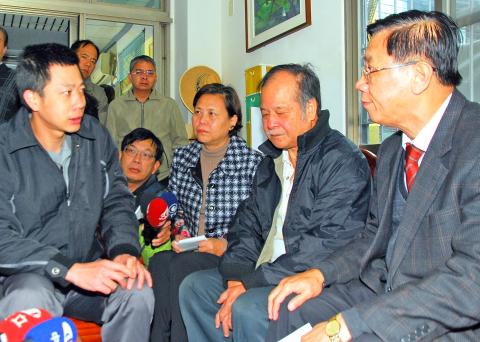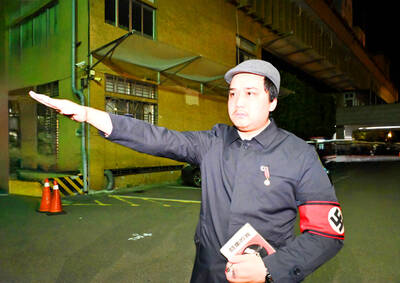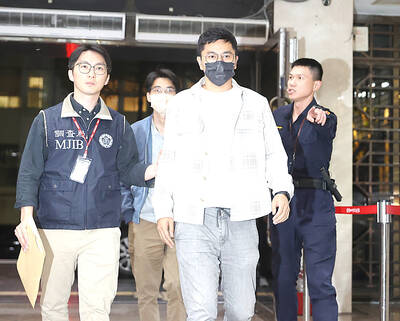The pilot of the TransAsia Airways Flight GE235 that crashed into the Keelung River in Taipei on Feb. 4 admitted that he shut down the wrong engine in a conversation recorded by the plane’s cockpit voice recorder, the Aviation Safety Council said yesterday.
Council executive director Thomas Wang (王興中) said that a master warning sounded after the aircraft climbed to 1,200 feet (365.8m). The aircraft’s engine warning display (EWD) then showed a series of steps that the pilot, Liao Chien-tsung (廖建宗), should have taken when the No. 2 engine flamed out after takeoff.
The pilot said that he shut down the No. 1 engine instead.

Photo: Hsieh Chieh-yu, Taipei Times
According to the transcript provided by the council, the pilot said: “Wow, pulled back the wrong side throttle,” about eight seconds before the plane crash.
As to why the pilot turned off the No. 1 engine when the EWD showed that the No. 2 engine was the problem, Wang said that the council would begin an analysis in the next phase of the investigation.
The initial investigation showed that four seconds after the flight began to take off, the copilot, Liu Tse-chung (劉自忠), cried out that the plane’s automatic takeoff power control system (ATPCS) was not armed.
Nevertheless, the pilot answered: “OK continue takeoff.”
At 10:52am, the copilot corrected himself, saying: “Oh, there it is. ATPCS is armed.”
Wang said that the ATPCS is a protection mechanism that increases power to the operating engine and turns off the bleed valve if the system detects that one of the two engines on the aircraft generates torque less than 18.5 percent. The system can also switch the failed engine to autofeather mode and inhibit the operating engine from being feathered, he said.
The feathered failed engine helps reduce drag so that the operating engine can generate sufficient power for the aircraft to continue flying, he added.
Wang said the council had inspected the engines and other devices on the ATR-600 aircraft. While the autofeather unit of the No. 1 engine passed the continuity test, the torque signal transmission of the same unit in the No. 2 engine was unstable during testing.
“The flight data recorder showed that the oil pressure, temperature and fuel flow of the No. 2 engine was normal and the engine was still running. However, the signal was not transmitted to the sensor in a reliable manner and the situation subsequently triggered the sequences of the ATPCS. The system then caused the engine to be feathered, which means that it no longer provided any power to the aircraft,” he said.
Data records also showed that the pilot disengaged the autopilot system at 10:52:41am, when the aircraft was at 1,300 feet.
At 10:52:43am, the pilot said: “I will pull back the throttle of the No. 1 engine,” with the copilot answering: “Wait a second, cross check.”
The copilot answered again at 10:53am, saying: “OK, engine flame out check. Check up-trim, yes. Auto-feather, yes.”
At 10:53:06am, the pilot repeated that he would shut down the No. 1 engine. At the same time, the copilot said that he had confirmed that the No. 2 engine was flamed out.
The condition lever of the No. 1 engine was pushed to the position to shut off the fuel at 10:53:24am, and the engine later went into the feather mode as well, according to the data.
At 10:54:05am, the copilot confirmed that they lost both engines. Though the pilot tried to restart the No. 1 engine, it did not accelerate fast enough to generate sufficient power to keep the plane in the air, the data showed.
The pilot verbally confirmed that he had shut down the wrong engine at 10:54:27am. At 10:54:35am, the aircraft crashed into the Keelung River, killing 43 people onboard.
The facts presented by the council also indicated that the pilot had once failed the simulator test to operate an ATR-600 aircraft. The airman overseeing the test said that the pilot had “insufficient knowledge of the quick reference book,” including knowledge on the engine flame out at takeoff. The pilot passed the test in July last year.
Civil Aeronautics Administration Flight Standard Division Director Clark Lin (林俊良) said that the operation manual of the ATR aircraft had said that the pilot should abort takeoff if the ATPCS is not armed and the operation speed fails to reach 70 knots.
Responding to the report, the brother of the pilot said that the council should not blame what happened on his brother and the copilot.
The copilot’s sister, Liu Chun-hsin (劉春新), said her brother and Liao had minimized casualties by avoiding densely populated zones.

Seventy percent of middle and elementary schools now conduct English classes entirely in English, the Ministry of Education said, as it encourages schools nationwide to adopt this practice Minister of Education (MOE) Cheng Ying-yao (鄭英耀) is scheduled to present a report on the government’s bilingual education policy to the Legislative Yuan’s Education and Culture Committee today. The report would outline strategies aimed at expanding access to education, reducing regional disparities and improving talent cultivation. Implementation of bilingual education policies has varied across local governments, occasionally drawing public criticism. For example, some schools have required teachers of non-English subjects to pass English proficiency

‘FORM OF PROTEST’: The German Institute Taipei said it was ‘shocked’ to see Nazi symbolism used in connection with political aims as it condemned the incident Sung Chien-liang (宋建樑), who led efforts to recall Democratic Progressive Party (DPP) Legislator Lee Kun-cheng (李坤城), was released on bail of NT$80,000 yesterday amid an outcry over a Nazi armband he wore to questioning the night before. Sung arrived at the New Taipei City District Prosecutors’ Office for questioning in a recall petition forgery case on Tuesday night wearing a red armband bearing a swastika, carrying a copy of Adolf Hitler’s Mein Kampf and giving a Nazi salute. Sung left the building at 1:15am without the armband and apparently covering the book with a coat. This is a serious international scandal and Chinese

TRADE: The premier pledged safeguards on ‘Made in Taiwan’ labeling, anti-dumping measures and stricter export controls to strengthen its position in trade talks Products labeled “made in Taiwan” must be genuinely made in Taiwan, Premier Cho Jung-tai (卓榮泰) said yesterday, vowing to enforce strict safeguards against “origin laundering” and initiate anti-dumping investigations to prevent China dumping its products in Taiwan. Cho made the remarks in a discussion session with representatives from industries in Kaohsiung. In response to the US government’s recent announcement of “reciprocal” tariffs on its trading partners, President William Lai (賴清德) and Cho last week began a series of consultations with industry leaders nationwide to gather feedback and address concerns. Taiwanese and US officials held a videoconference on Friday evening to discuss the

PERSONAL DATA: The implicated KMT members allegedly compiled their petitions by copying names from party lists without the consent of the people concerned Judicial authorities searched six locations yesterday and questioned six people, including one elderly Chinese Nationalist Party (KMT) member and five KMT Youth League associates, about alleged signature forgery and fraud relating to their recall efforts against two Democratic Progressive Party (DPP) legislators. After launching a probe into alleged signature forgery and related fraud in the KMT’s recall effort, prosecutors received a number of complaints, including about one petition that had 1,748 signatures of voters whose family members said they had already passed away, and also voters who said they did not approve the use of their name, Taipei Deputy Chief Prosecutor